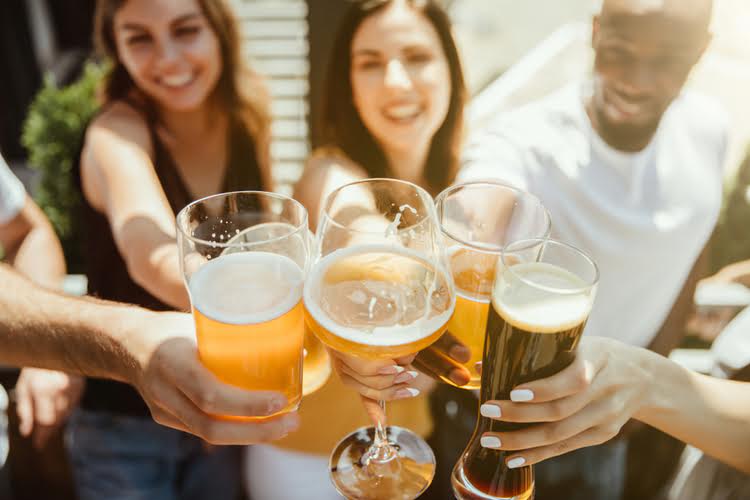Usually this is based on behaviour over the last 12 months or more, but alcohol dependence could be diagnosed based on continuous daily (or almost daily) use of alcohol over a period of at least three months. Doctors assess whether someone is dependent on alcohol by looking for signs that show their patient can’t regulate their drinking, and that they have a strong internal drive to use alcohol. Then, as dependence takes over, it’s possible you will find 29 Best Group Therapy Activities for Supporting Adults you get the shakes if you don’t have a drink, and so feel the need to keep drinking to avoid experiencing very unpleasant withdrawal symptoms. As dependence gets more established, you might find you end up spending most of your time thinking about alcohol or engaging in activities necessary to obtain, consume, or recover from the effects of drinking. The risk of developing a range of health problems increases the more you drink on a regular basis.

However, most people with AUD—no matter their age or the severity of their alcohol problems—can benefit from treatment with behavioral health therapies, medications, or both. Chronic, heavy alcohol use also wreaks havoc on the brain’s reward system, which can alter the way the brain perceives pleasure and limit a person’s ability to control his or her behavior. Over time, these changes, along with the effects of tolerance and withdrawal, can create a vicious cycle of dependence that keeps the person hooked on alcohol. At the same time, the drinker will likely begin to experience intense cravings for alcohol and distressing physical withdrawal symptoms, such as sweating, anxiety, tremors, an elevated heart rate and insomnia, when they stop drinking.
Alcohol withdrawal
In some cases, alcohol withdrawal can present heightened risks and even lead to fatality. As a result, it is recommended that anyone seeking to detox from alcohol consult a medical professional first. However, if a person has an attachment to drinking, such as relying on it to “have a good time,” they may develop problematic drinking habits and eventually develop an AUD. If alcohol dependence sets in, it will likely be more difficult to stop drinking because of the presence of withdrawal symptoms and possibly cravings for alcohol. If you feel that you sometimes drink too much alcohol, or your drinking is causing problems, or if your family is concerned about your drinking, talk with your health care provider.

Alcoholics also suffer from withdrawal and will drink to avoid the symptoms of withdrawal, which include anxiety, tremors, sweating, insomnia, nausea, depression, fatigue, headache, and irritability. “Problematic drinking patterns could be a warning sign of future mental health problems, so helping young people to avoid problematic alcohol use could have long-term benefits to their mental health.” We aimed to investigate whether alcohol dependence, but not high frequency or quantity of consumption, during adolescence increased the risk of depression in young adulthood. This paper looked at the association between alcohol consumption and signs of problematic drinking, or dependence, at age 18, and depression six years later at age 24. This experimental design can be further modified by the use of discriminative contextual cues.
Rethinking Drinking
Sometimes, however, that support might require you to give them time and space so they can do the hard work recovery necessitates. However, American Addiction Centers (AAC) often advises spouses and other family members to “lovingly disconnect” from their loved one while they are in treatment, allowing your loved one to fully adjust to their new environment and see the benefits treatment will provide. A loss of work income lowers social security contributions and contributions to employer-provided or independent retirement accounts. Additionally, a loss of employment could lead to more out-of-pocket costs for health insurance plans, especially if a health insurance plan had been partially paid for by an employer.
The research, involving 3,902 participants from the ALSPAC study, examined the correlation between alcohol consumption and dependency at age 18 and depression at age 24. Taken together, a substantial body of evidence suggests that changes in CRF function within the brain and neuroendocrine systems may influence motivation to resume alcohol self-administration either directly and/or by mediating withdrawal-related anxiety and stress/dysphoria responses. People ages 12 to 20 drink 3.4% of all alcohol consumed in the United States.4 Although youth drink less often than adults, when they do drink, they drink more. More than 90% of all beverages containing alcohol consumed by youth are consumed through binge drinking5 (see the “What Is Binge Drinking?” box). Either directly or indirectly, we all feel the effects of the aggressive behavior, property damage, injuries, violence, and deaths that can result from underage drinking. Alcohol is the most widely used substance among America’s youth and can cause them enormous health and safety risks.
Is There a Difference in Alcohol Abuse and Addiction?
One of the most commonly used to probe non-drug related reward sensitivity is the monetary incentive delay (MID) task [98], whereas to measure drug-related reward, cue-reactivity tasks are usually employed [99]. Most commonly these tasks consist of presenting the individual with static or video imagery of a ‘cue’, typically drug or related paraphernalia, however, smell and taste can also be used. Contrary to myth, being able to “hold your liquor” means you’re probably more at risk — not less — for alcohol problems.

Concerns about paying for rehab services should never be a barrier to alcohol addiction treatment. Because your inhibitions are lowered when you drink alcohol, you may be more likely to impulsively buy things without thinking through the consequences https://g-markets.net/sober-living/the-best-gifts-for-celebrating-1-year-sobriety/ of those purchases. For instance, a person who is intoxicated may spend more money than planned at a bar. A doctor may diagnose alcohol dependence if you show two or more of the above symptoms based on the ongoing pattern of how you use alcohol.
4.1. Family history
Theories suggest that for certain people drinking has a different and stronger impact that can lead to alcohol use disorder. Alcohol use disorder is a pattern of alcohol use that involves problems controlling your drinking, being preoccupied with alcohol or continuing to use alcohol even when it causes problems. This disorder also involves having to drink more to get the same effect or having withdrawal symptoms when you rapidly decrease or stop drinking. Alcohol use disorder includes a level of drinking that’s sometimes called alcoholism. The scatter plot compares the prevalence of alcohol use disorders in males versus that of females. The prevalence of alcohol dependence in men is typically higher than in women across all countries.
- The charts show global consumption of spirits, which are distilled alcoholic drinks, including gin, rum, whisky, tequila, and vodka.
- Poorer individuals experience greater health and social harms from alcohol consumption than more affluent individuals.
- This section summarizes PET studies that investigate the key neurotransmitter systems and review the evidence in case-control studies (summarized in Table 1).
As these changes occur, people require increasingly larger amounts of alcohol to become intoxicated. The brain’s endogenous opioid system is also affected by alcohol (Oswald & Wand, 2004). Alcohol stimulates endogenous opioids, which are thought to be related to the pleasurable, reinforcing effects of alcohol. Opioids in turn stimulate the dopamine system in the brain, which is thought to be responsible for appetite for a range of appetitive behaviours including regulation of appetite for food, sex and psychoactive drugs. The dopamine system is also activated by stimulant drugs such as amphetamines and cocaine, and it is through this process that the individual seeks more drugs or alcohol (Everitt et al., 2008; Robinson & Berridge, 2008).